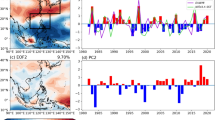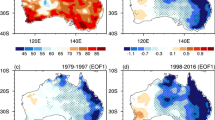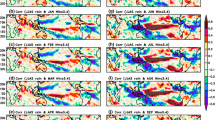Abstract
During the winter season (Dec., Jan., and Feb.; DJF) the western Himalaya (WH) receives one-third of its annual precipitation due to Indian winter monsoon (IWM). The IWM is characterized by eastward-moving synoptic weather systems called western disturbances. Seasonal interannual precipitation variability is positively correlated with monthly interannual variabilities. However, it was found that the monthly interannual variabilities differ. The interannual variability for Jan. is negatively correlated with that for Dec. and Feb. Because the entire seasonal interannual variability is in phase with the El Niño Southern Oscillation, it is interesting to investigate such contrasting behavior. Composite analysis based on extreme wet and dry seasons indicates that Dec. and Feb. precipitation variabilities have a high positive (low negative) correlation with eastern (western) equatorial Pacific warming (cooling), whereas Jan. precipitation variability exhibits negligible correlations. Seasonal mid/upper tropospheric cooling over the Himalayas enhances anomalous cyclonic circulation, which along with suppressed convection over the western equatorial Pacific, shifts the 200-hPa subtropical westerly jet southward over the Himalayas. Due to the upper tropospheric anomalous cyclonic circulation, mass transfer favors anticyclone formation at the mid/lower troposphere, which is enhanced in Jan. due to a warmer mid troposphere and hence decreases precipitation compared with Dec. and Feb. Additionally, a weakening of meridional moisture flux transport from the equatorial Indian Ocean to WH is observed in Jan. Further analysis reveals that mid-tropospheric and surface temperatures over WH also play dominant roles, acting as local forcing where the preceding month’s surface temperature controls the succeeding month’s precipitation.












Similar content being viewed by others
References
Adler RF, Huffman GJ, Chang A, Ferraro R, Xie P, Janowiak J, Rudolf B, Schneider U, Curtis S, Bolvin D, Gruber A, Susskind J, Arkin P (2003) The version 2 global precipitation climatology project (GPCP) monthly precipitation analysis (1979–Present). J Hydrometeor 4:1147–1167
Bony S, Collins WD, Fillmore DW (2000) Indian Ocean low clouds during the winter monsoon. J Climate 13:2028–2043
Dai J (1990) Climate in the Qinghai-Xizang Plateau (in Chinese). China Meteorol, Beijing
Dimri AP (2005) The contrasting features of winter circulation during surplus and deficient precipitation over Western Himalayas. PAGEOPH 162(11):2215–2237
Dimri AP (2006) Surface and upper air fields during extreme winter precipitation over Western Himalayas. PAGEOPH 163(8):1679–1698
Dimri AP (2007) The transport of mass, heat and moisture over the western Himalayas during winter season. Theoret Appl Climatol 90(1–2):49–63
Dimri AP (2012) Relationship between ENSO phases and northwest India winter precipitation. Int J Climatol. doi:10.1002/joc.3559
Dimri AP (2013) Interannual variability of Indian winter monsoon over the Western Himalaya. Global and Planetary Change (accepted)
Dimri AP, Mohanty UC (2009) Simulation of mesoscale features associated with intense western disturbances over western Himalayas. Meteorol Appl 16:289–308
Hadley Centre (2006) HadiSST 1.1 global sea-ice coverage and SST (1870–present). British Atmospheric Data Centre. http://badc.nerc.ac.uk/data/hadisst
Kanamitsu M, Ebisuzaki W, Woollen J, Yang S-K, Hnilo JJ, Fiorino M and Potter GL (2002) NCEP-DEO AMIP-II reanalysis (R-2). Bull Amer Met Soc 83:1631–1643
Karamuri A, Behera SK, Rao SA, Weng H, Yamagata T (2007) El Niño Modoki and its possible teleconnection. J Geophys Res 112:C11007. doi:10.1029/2006JC003798
Karamuri A, Tam C-Y, Lee W-J (2009) ENSO Modoki impact on the southern Hemisphere storm track activity during extended austral winter. Geophys Res Lett 36:L12705. doi:10.1029/2009GL038847
Kawamura R (1998) A possible mechanism of the Asian summer monsoon–ENSO coupling. J Met Soc Jap 76(6):1009–1027
Kim H-M, Webster PJ, Curry JA (2009) Impact of shifting patterns of Pacific Ocean warming on North Atlantic equatorial cyclones. Science 325:77–80
Kripalani RH, Kumar P (2004) Northeast monsoon rainfall variability over south peninsular India vis-à-vis Indian Ocean dipole mode. Int J Clim 24:1267–1282
Kriplani RH, Kulkarni A (1997) Climatic impact of El Nino/La Nina on the Indian monsoon: a new perspective. Weather 52:39–46
Krishnakumar K, Rajagopalan B, Cane MA (1999) On the weakening relationship between in Indian monsoon and ENSO. Science 284:2156–2159
Krishnakumar K, Rajagopalan B, Hoerling M, Bates G, Cane MA (2006) Unraveling mystery of Indian monsoon failure during El Niño. Science 314:115–119
Kuchraski F, Bracco A, Yoo JH, Molteni F (2007) Low-frequency variability of the Indian monsoon-ENSO relationship and the equatorial Atlantic: the “weakening” of the 1980s and 1990s. J Clim 20:4255–4265
Kumar P, Rupakumar K, Rajeevan M, Sahai AK (2007) On the recent strengthening of the relationship between ENSO and northeast monsoon rainfall over South Asia. Clim Dyn 28:649–660
Laat ATJ and Lelieveld J (2002) Interannual variability of the Indian winter monsoon circulation and consequences for pollution levels. J Geophys Res 107, D24, 4739. doi:10.1029/2001JD001483
Lang T, Barros AP (2004) Winter storm in the central Himalayas. J Meteorol Soc Jpn 82:829–844
Liebmann B, Smith CA (1996) Description of complete (interpolated) outgoing longwave radiation dataset. Bull Amer Meteoro Soc 77:1275–1277
New MG, Hulme M, Jones PD (2000) Representing twentieth century space–time climate variability, Part II. Development of a 1901–96 monthly grid of terrestrial surface climate. J Climate 13:2217–2238
Pant GB, Rupakumar K (1997) Climates of South Asia. Wiley, New York
Roy SS (2006) The impacts of ENSO, PDO and local SST on winter precipitation in India. Phys Geogr 27(5):464–474
Rudolf B, Beck C, Grieser J and Schneider U (2005) Global precipitation analysis products. Global precipitation climatology centre (GPCC), DWD, Internet publication 1–8
Saha SK, Haldar S, Krishnakumar K, Goswami BN (2012) Pre-onset land surface processes and ‘internal’ interannual variabilities of the Indian summer monsoon. Clim Dyn 36:2077–2089
Tanaka HL, Ishizaki N, Kitoh A (2004) Trend and interannual variability of Walker, monsoon and Hadley circulations defined by velocity potential in the upper troposphere. Tellus 56A:250–269
Ueno K (2005) Synoptic conditions causing nonmonsoon snowfalls in the Tibetan Plateau. Geophys Res Lett 32:L01811. doi:10.1029/2004GL021421
Ueno K, Aryal R (2008) Impact of equatorial convective activity on monthly temperature variability during nonmonsoon season in the Nepal Himalayas. J Geophys Res 113:D18112. doi:10.1029/2007JD009524
Ueno K, Toyotsu K, Bertolani L, Tartari G (2008) Stepwise onset of monsoon weather observed in the Nepal Himalayas. Mon Wea Rev 136:2507–2522
Yadav RK (2011) Why is ENSO influencing Indian northeast monsoon in the recent decades? Int J Clim. doi:10.1002/joc.2430
Yadav RK, Yoo JH, Kucharski F, Abid MA (2010) Why is ENSO influencing northwest India winter precipitation in recent decades? J Clim 23:1979–1993
Yasunari T (1990) Impact of Indian monsoon on coupled atmosphere/ocean system in the equatorial pacific. Meteoro Atmos Phys 90(1):35–57
Yatagai A, Arakawa O, Kamiguchi K, Kawamoto H (2009) A 44-year daily gridded precipitation dataset for Asia based on a dense network of rain gauges. SOLA 5:137–140
Yeh SW, Kug JS, Dewitte B, Kwon MH, Kirtman B, Jin FF (2009) El Niño in a changing climate. Nature 461:511–514
Yu R, Wang B, Zhou T (2004) Tropospheric cooling and summer monsoon weakening trend over east Asia. Geophys Res Lett 31:L22212. doi:10.1029/2004GL021270
Author information
Authors and Affiliations
Corresponding author
Rights and permissions
About this article
Cite this article
Dimri, A.P. Sub-seasonal interannual variability associated with the excess and deficit Indian winter monsoon over the Western Himalayas. Clim Dyn 42, 1793–1805 (2014). https://doi.org/10.1007/s00382-013-1797-6
Received:
Accepted:
Published:
Issue Date:
DOI: https://doi.org/10.1007/s00382-013-1797-6




